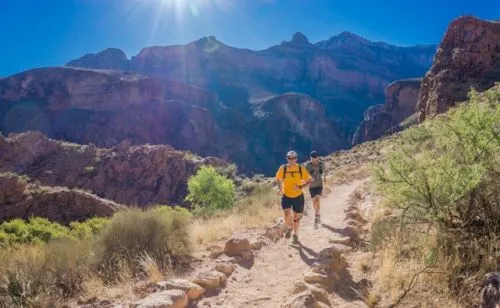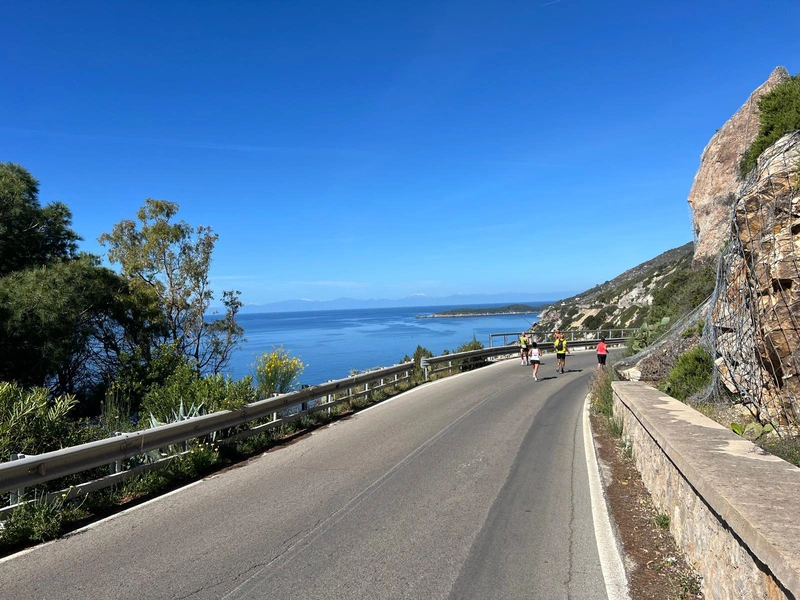Estimating the impact of climbs and descents on running pace
How much does running speed change on hilly courses?
Go&Race provides an altimetric profile analysis tool to obtain an estimate of the equivalent speed on flat ground.
CLICK HERE to Skip intro & analyze your course!
Running Speed on Hilly Courses
When running on paths with elevation changes, average speed can be significantly impacted compared to flat courses.
It is known, in fact, that the decrease in running pace on uphill sections is only partially compensated by the faster
pace on downhill sections.
As a result, a route with equal amounts of uphill and downhill is generally completed in longer times than a flat route
of the same distance.
But how can we calculate this difference and what factors influence it?

The Challenge of Estimating Speed on Hilly Courses
Calculating running speed on a hilly course versus a flat one is a complex problem, because it depends on various factors,
including:
- runner's fitness level: higher fitness levels may lead to better adaptation to elevation changes;
- slope of the route: steeper inclines or declines have a more pronounced effect on pace;
- distribution of ascents and descents: the order and frequency of hills can alter the overall pace;
- running surface: uneven, wet, or slippery terrain can slow a runner down even further.
To estimate the variation in speed caused by elevation changes, algorithms and models are used to calculate the so-called
Grade Adjusted Pace (GAP).
Grade Adjusted Pace (GAP) - Known Calculation Methods
One of the best-known models is the formula proposed by Professor Minetti in 2002. This algorithm explores the relationship
between energy expenditure and ground slope, providing a method to calculate the optimal speed for inclined terrains.
However, Minetti’s model is complex and requires detailed data on ground conditions.
A simpler and more commonly used estimation method involves these steps:
1) Uphill adjustments: Add 15–20 seconds per 10 meters (approximately 33 feet) of positive elevation gain for every
kilometer (0.62 miles) of running.
2) Downhill adjustments: Subtract 5–10 seconds per 10 meters of negative elevation gain for every kilometer of running.
For example, consider a 10 km course with 100 meters of total positive elevation gain and 100 meters of negative
elevation loss. If the flat-ground running time is 60 minutes (6 minutes/km or 9'39"/mile):
- For the 100 meters uphill, add 150–200 seconds.
- For the 100 meters downhill, subtract 50–100 seconds.
This results in an adjusted total time of 60:50 (best-case scenario) to 62:30 (worst-case scenario). The corresponding pace
ranges between 6:05/km (9'47"/mile) and 6:15/km (10'03"/mile), representing a speed loss of 5–15 seconds per kilometer
(8–24 seconds per mile).
A variation of this method, suggested by Jack Daniels in Daniels’ Running Formula, adds 18–24 seconds for every 10 meters
of ascent and subtracts 8–12 seconds for every 10 meters of descent.
The main limitation of these approaches is that they do not account for the steepness of the slope. Estimates become
highly inaccurate for steep inclines or declines, where running is either extremely inefficient or not feasible.
To address this issue, the Go&Race algorithm, which we will now explain, offers a more refined solution.

The Go&Race Algorithm Based on Elevation Profiles (Version 1.0, 2024)
Our experimental method relies on analyzing the elevation profile of a course: by reading data from a .gpx file,
we extract slope information and apply the Go&Race algorithm, developed through extensive analysis of training sessions and races.
Essentially, the algorithm recalculates running speed along the route, taking slope into account.
The following zones are identified:
- Downhill gradients between -8% and -12%: These provide the maximum possible advantage, with an approximate 13%
increase in speed.
- Downhill gradients steeper than -12%: The downhill advantage decreases rapidly, disappearing entirely around
a -17% gradient.
Beyond this point, running speed becomes slower than on flat terrain.
- Uphill gradients: The reduction in speed is more pronounced. At a 10% uphill gradient, running speed decreases by
approximately 45%.
- Due to the uncertainty in the elevation and slope data, no correction is applied for slopes ranging between -1% and +1%.
This model provides a more accurate representation of performance variations due to slope, enabling runners and race organizers
to better predict and plan for elevation-related challenges.
GNR-GAP index
Disclaimer - The algorithm and definition of the GNR-GAP index were released in November 2024 (version 1.0) and are considered to be in the testing phase. Any changes due to errors or improvements will be communicated on this page.
The Go&Race algorithm calculates the GNR-GAP index, an index that represents the percentage change in an athlete's
speed on a hilly course compared to a flat course.
A GNR-GAP of 25 indicates a 25% slower pace. Negative values indicate a
faster pace and occur in the case of downhill paths.

EXAMPLE 1 - Elba Marathon, Italy

Let's start with this first example using the elevation profile of the Elba Marathon, a 42.2 km race held in May in Tuscany on a
stunning panoramic course overlooking the sea. Based on the 2024 course data, the race is characterized by numerous rolling hills,
with a minimum elevation of 0 meters above sea level and a maximum of 90 meters, totaling approximately 530 meters of both ascent and descent.
The following graphs display the elevation profile and slope gradient of the course.
Using our algorithm, we estimate a pace that is 4.5% slower than on a flat course.
For instance, if a runner is capable of completing a flat marathon at a pace of 5'00"/km (8'03"/mi), equivalent to a finish time of 3h30'58", the adjusted estimated
finish time would be 3h40'27". The recalculated average pace (GAP) rises to 5'13"/km (8'25"/mi), meaning the pace slows by 0'13"/km (+0'22"/mi).
The following graph illustrates the Pace Adjustment (PA) factor applied along the course. The horizontal red line represents a PA of 1, which indicates no adjustment. Above the line, the pace is slower, while below the line, the pace is faster.
A table below provides estimates for various other paces.
| Pace (min/km) | Pace (min/mile) | Time without slopes (hh:mm:ss) | Time with slopes (hh:mm:ss) | GAP (min/km) | Δ Pace (min/km) | GAP (min/mile) | Δ Pace (min/mile) |
|---|---|---|---|---|---|---|---|
| 3'00" | 4'50" | 2h06'35" | 2h12'16" | 3'08" | 0'08" | 5'03" | 0'13" |
| 3'30" | 5'38" | 2h27'40" | 2h34'19" | 3'39" | 0'09" | 5'53" | 0'15" |
| 4'00" | 6'26" | 2h48'46" | 2h56'22" | 4'11" | 0'11" | 6'44" | 0'17" |
| 4'30" | 7'15" | 3h09'52" | 3h18'24" | 4'42" | 0'12" | 7'34" | 0'20" |
| 5'00" | 8'03" | 3h30'58" | 3h40'27" | 5'13" | 0'13" | 8'25" | 0'22" |
| 5'30" | 8'51" | 3h52'04" | 4h02'30" | 5'45" | 0'15" | 9'15" | 0'24" |
| 6'00" | 9'39" | 4h13'10" | 4h24'33" | 6'16" | 0'16" | 10'05" | 0'26" |
| 6'30" | 10'28" | 4h34'16" | 4h46'36" | 6'48" | 0'18" | 10'56" | 0'28" |
| 7'00" | 11'16" | 4h55'21" | 5h08'38" | 7'19" | 0'19" | 11'46" | 0'30" |
EXAMPLE 2 – Pikes Peak Marathon, United States

In this second example, we thoroughly test the Go&Race algorithm using the elevation data from the Pikes Peak Marathon, a
42.2 km race held in Colorado, United States.
The 2024 course profile reveals a challenging route: the first half consists entirely of an uphill climb, taking runners from an
altitude of approximately 1920 m to 4280 m, followed by a descent along the same path. The total elevation gain and loss amount to 2360 m.
This marathon is run on a trail primarily composed of dirt and gravel, which inherently slows the pace compared to asphalt. Additionally,
obstacles like roots and rocky protrusions are present, further complicating the course. These elements are not accounted for in our algorithm,
so additional time would need to be added to the estimate depending on the runner's technical ability to handle such terrain.
The graphs below show the elevation profile and the slope gradients of the course.
Considering these factors, and noting that the algorithm exclusively evaluates the impact of the elevation profile, the results indicate
that the average pace on this course will be AT LEAST 35.6% slower than on a flat course.
For example, a runner capable of completing a flat marathon at a pace of 5'00"/km (8'03"/mi), with a finish time of 3h30'58", would have an estimated time of 4h46'05" on this course.
The recalculated average pace (GAP) would rise to 6'47"/km (10'55"/mi), representing a slowdown of 1'47"/km (+2'52"/mi).
The next graph illustrates the Pace Adjustment (PA) factor applied to the pace along the course. The horizontal red line represents a PA of 1, indicating no adjustment to the pace. Above the line, the pace is slower; below the line, it is faster.
The results would be more accurate for a paved and less technical course. To provide a more comprehensive view of performance expectations on this challenging route, we include a table with estimates for other paces.
| Pace (min/km) | Pace (min/mile) | Time without slopes (hh:mm:ss) | Time with slopes (hh:mm:ss) | GAP (min/km) | Δ Pace (min/km) | GAP (min/mile) | Δ Pace (min/mile) |
|---|---|---|---|---|---|---|---|
| 3'00" | 4'50" | 2h06'35" | 2h51'39" | 4'04" | 1'04" | 6'33" | 1'43" |
| 3'30" | 5'38" | 2h27'40" | 3h20'16" | 4'45" | 1'15" | 7'38" | 2'00" |
| 4'00" | 6'26" | 2h48'46" | 3h48'52" | 5'25" | 1'25" | 8'44" | 2'18" |
| 4'30" | 7'15" | 3h09'52" | 4h17'29" | 6'06" | 1'36" | 9'49" | 2'35" |
| 5'00" | 8'03" | 3h30'58" | 4h46'05" | 6'47" | 1'47" | 10'55" | 2'52" |
| 5'30" | 8'51" | 3h52'04" | 5h14'42" | 7'28" | 1'58" | 12'00" | 3'09" |
| 6'00" | 9'39" | 4h13'10" | 5h43'19" | 8'08" | 2'08" | 13'06" | 3'26" |
| 6'30" | 10'28" | 4h34'16" | 6h11'55" | 8'49" | 2'19" | 14'11" | 3'43" |
| 7'00" | 11'16" | 4h55'21" | 6h40'32" | 9'30" | 2'30" | 15'17" | 4'01" |
ESEMPIO 3 - Loch Ness Marathon, Scotland

As a final example, we analyze the elevation profile of the Loch Ness Marathon, a 42.2 km race held in September in Scotland. This
course is notable for its net downhill profile. Based on the 2024 data, the race begins at an elevation of 265 meters and finishes
at sea level. The total elevation change includes approximately 30 meters of ascent and nearly 300 meters of descent.
The graphs below display the elevation profile and the slope gradients of the course.
The elevation profile indicates that the downhill advantage diminishes after approximately 16 km. Overall, the algorithm estimates
a 1.8% performance gain compared to a flat course.
For example, a runner capable of completing a flat marathon at 5'00"/km (8'03"/mi), with a finish time of 3h30'58", would have an estimated
finish time of 3h27'10" on this course.
The recalculated average pace (GAP) would decrease to 4'55"/km (7'54"/mi), making it 0'05"/km (-0'09"/mi) faster.
The next graph illustrates the Pace Adjustment (PA) factor applied to the pace along the course.
The horizontal red line represents a PA of 1, indicating no correction to the pace.
Below the line, the pace is faster; above the line, it is slower.
As can be observed, from kilometer 16 onward, the algorithm does not apply any adjustments to the estimated pace, as the slopes fall within the range
of -1% to +1%.
The table below provides performance estimates for other pace ranges, offering a more comprehensive view of expected times on this route.
| Pace (min/km) | Pace (min/mile) | Time without slopes (hh:mm:ss) | Time with slopes (hh:mm:ss) | GAP (min/km) | Δ Pace (min/km) | GAP (min/mile) | Δ Pace (min/mile) |
|---|---|---|---|---|---|---|---|
| 3'00" | 4'50" | 2h06'35" | 2h04'18" | 2'57" | 0'03" | 4'44" | 0'05" |
| 3'30" | 5'38" | 2h27'40" | 2h25'01" | 3'26" | 0'04" | 5'32" | 0'06" |
| 4'00" | 6'26" | 2h48'46" | 2h45'44" | 3'56" | 0'04" | 6'19" | 0'07" |
| 4'30" | 7'15" | 3h09'52" | 3h06'27" | 4'25" | 0'05" | 7'07" | 0'08" |
| 5'00" | 8'03" | 3h30'58" | 3h27'10" | 4'55" | 0'05" | 7'54" | 0'09" |
| 5'30" | 8'51" | 3h52'04" | 3h47'54" | 5'24" | 0'06" | 8'42" | 0'10" |
| 6'00" | 9'39" | 4h13'10" | 4h08'37" | 5'54" | 0'06" | 9'29" | 0'10" |
| 6'30" | 10'28" | 4h34'16" | 4h29'20" | 6'23" | 0'07" | 10'16" | 0'11" |
| 7'00" | 11'16" | 4h55'21" | 4h50'03" | 6'52" | 0'08" | 11'04" | 0'12" |
Course Analysis - Upload your file GPX
Upload a GPX file to analyze slopes, estimate travel time, or evaluate performance.
If needed, fill in the "Declared Distance" field to use the official course distance in the calculations instead of the GPS-measured distance, which may contain inaccuracies. This field is optional and can be left blank.
